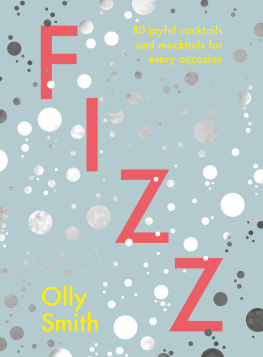CONTENTS
How to use this eBook
Preferred application settings
For the best reading experience, the following application settings are recommended:
- Color theme: White background
- Font size: At the smallest point size
- Orientation: Landscape(for screen sizes over 9),Portrait(for screen sizes below 9)
- Scrolling view: [OFF]
- Text alignment: Auto-justification [OFF](if the eBook reader has this feature)
- Auto-hyphenation: [OFF](if the eBook reader has this feature)
- Font style: Publisher default setting [ON](if the eBook reader has this feature)
AUTHORS NOTE
I FELL IN LOVE WITH this industry because of my love of people and the social aspect that comes with a cocktail. A drink is so much more than a blend of ingredients; its an experience of history, learning, creativity, and sociability.
As someone whos never had a detailed life plan, I tend to follow the ethos of do what makes you happy and you will end up in a job that makes you happy. I stumbled upon the wine and spirits industry as a student in Leeds trying to be more self-sufficient, and I havent stopped working since. The industry is physically, mentally, and emotionally challenging, and it can be exhausting. But if youre up for the challenge, it can also be incredibly rewarding.
Approximately 3 years ago, I was offered an opportunity I couldnt resist. At the time, I was a working at legendary Leeds bar Oporto. I got talking to Declan McGurk, manager of the American Bar at The Savoy Hotel, and a few weeks later, he asked me to join his team. Since then, so many of my wildest dreams have come true. Under the patient teaching of head bartender Erik Lorincz, I now hold the position of senior bartenderthe first female to take on such a role in a century. I have seen the bar itself grow, and I have witnessed and been a part of some of the most memorable achievements in its incredibly long history. In October 2017, it was crowned the Worlds Best Bar.
A large part of that history comes from a man named Harry Craddock, head bartender of the American Bar in the 1920s and 30s. He created The Savoy Cocktail Book , probably the most important cocktail book of the 20th century and a text that has guided bartenders globally for decades. It has been a huge pillar of my learning, and a great source of inspiration and wisdom when writing this book; you will see many references to it as you read through! From my own Pearfection spritz to the American Bars Moonwalk, the following pages are a combination of three of my loves: cheesy puns, fizz, and cocktails
LETS GET FIZZICAL!
Where do the bubbles in sparkling wine come from? Whats the difference between brut and demi-sec? Can you cheat with Cava instead of Champagne? Become a fizz whiz and get the lowdown on some of the most popular bubbly beveragesalthough there are many more sparkling wines from around the world to explore!
HOW DO THEY MAKE IT BUBBLY?
THE SPARKLE IN FIZZY WINES is caused by carbon dioxide, a natural by-product of fermentation. Any fizz produced in winemaking is usually let loose to create still white or red wine, but some wines taste better with bubbles. To capture the sparkle, winemakers must stage an intervention, trapping and enhancing the bubbles in a tightly sealed bottle or tank.
FERMENTATION
AS THE SUGAR is consumed by the yeast, alcohol is produced, along with carbon dioxide. The result is a dry (low-sugar) base wine.
Sugar
This comes from the juice of the grapes. The grapes also contain acids and tannins (a bitter compound), which add to the flavor.
Yeast
Yeasts (microscopic organisms) occur naturally on grape skins, although they are often introduced artificially for better results.
Alcohol
The sugar is eaten by the yeast and converted into alcohol. Heat, aromas, and carbon dioxide are also produced.
THE TRADITIONAL METHOD
PIONEERED IN CHAMPAGNE, this is the original way of making fizz and a marker of premium wine. It is a legal requirement that all Champagne is made via this method. It is a time-consuming, laborious, and expensive process, but it produces great results. Secondary fermentation occurs inside each individual bottle.
1. Base wine
A still base wine is made. This is fermented dry (with low sugar), often using underripe grapes.
2. Bottle and sweeten
With the addition of a little more sugar and yeast, the bottles of base wine are tightly sealed.
3. Secondary fermentation
This creates more carbon dioxide in the sealed bottle, carbonating the wine.
4. Autolysis (aging)
The lees (dead yeast particles) are left in the bottle for months or even years. Contact with the lees creates complexity.
5. Disgorging
After aging, the lees will have risen to the neck of the bottle. They are frozen so they can be easily removed as a block of ice.
6. Dosage
Before the wine is resealed, sugar (dosage) is added. The amount of sugar depends on the desired level of sweetness.
THE TANK METHOD
MANY FIZZY WINES are now made via less time-consuming methods. In the tank method, the aging stage is skipped because the wines are intended to be fresh and young. As the name suggests, the bubbles are created in a pressurized tank rather than in the bottle. The advantage of this method is that the wine can be produced in bulk. It is faster and more economical than the traditional method.
FIZZ KNOW-HOW
TO MAKE the best cocktails, you need to know exactly how to handle your fizz. Plus, having a few fun facts up your sleeve is a great way to amuse your guests while you make the drinks. Its time to brush up on your bubbly knowledge, become a fizz whiz, and put the pro in Prosecco.

























